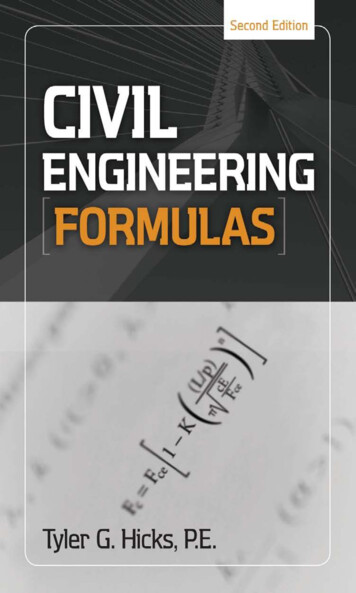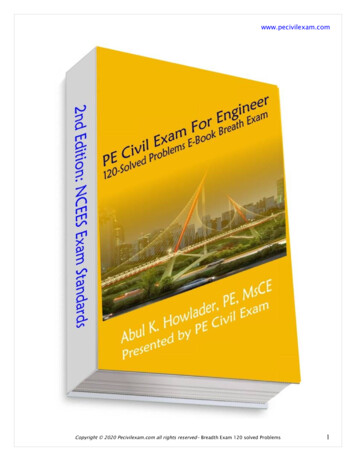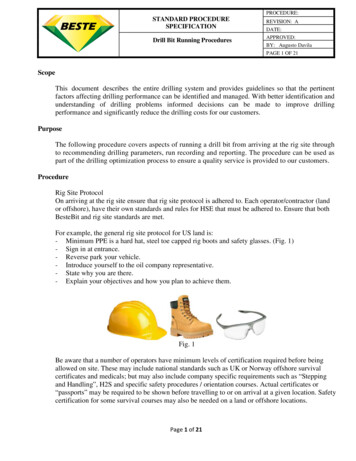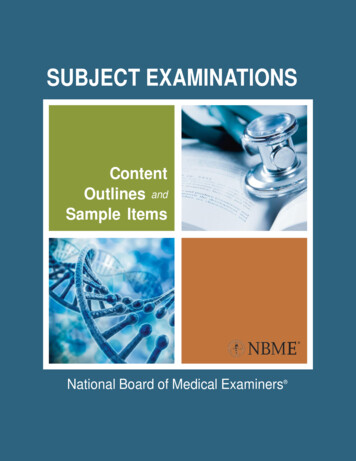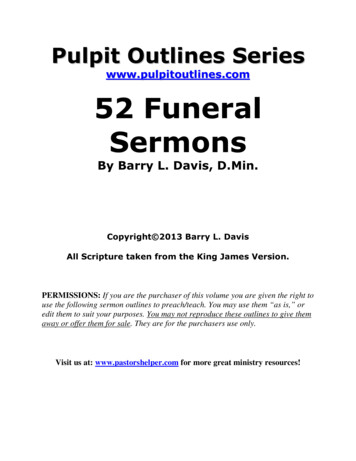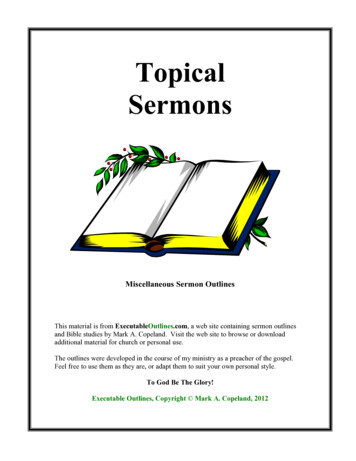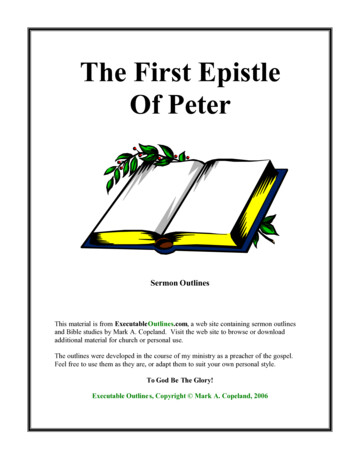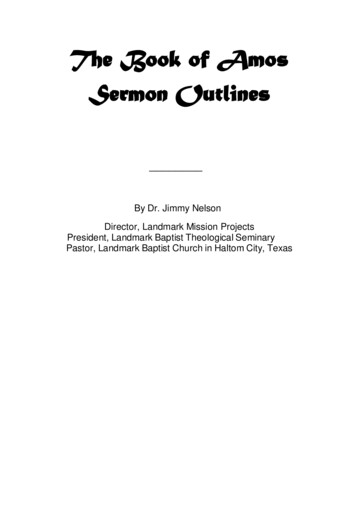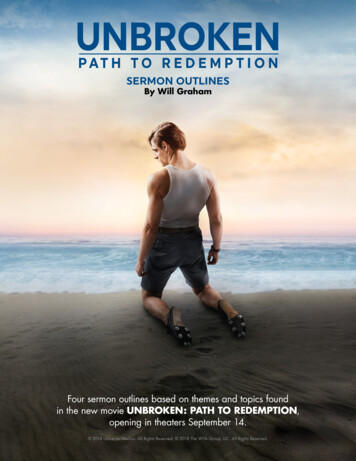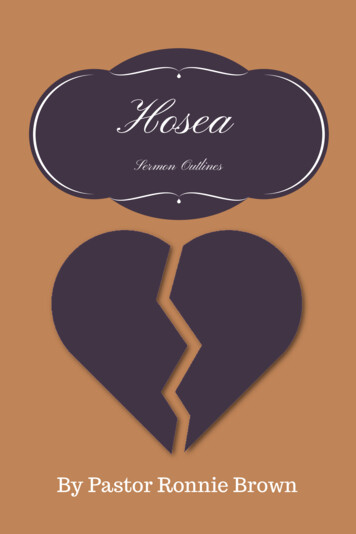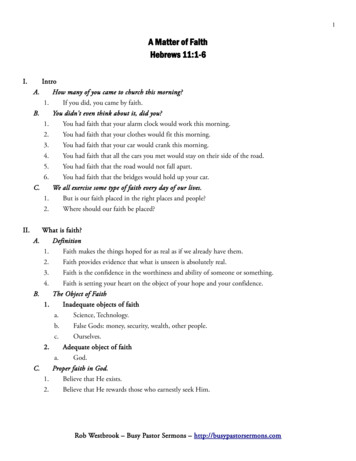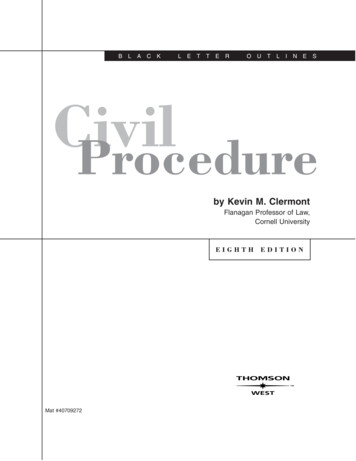
Transcription
BLAC KL ETTEROUTLINESCivilProcedureby Kevin M. ClermontFlanagan Professor of Law,Cornell UniversityEIGHTH EDITIONMat #40709272
Thomson/Reuters have created this publication to provide you with accurate and authoritativeinformation concerning the subject matter covered. However, this publication was not necessarilyprepared by persons licensed to practice law in a particular jurisdiction. Thomson/Reuters are notengaged in rendering legal or other professional advice, and this publication is not a substitute for theadvice of an attorney. If you require legal or other expert advice, you should seek the services of acompetent attorney or other professional.Black Letter Series and Black Letter Series design appearing on the front coverare trademarks registered in the U.S. Patent and Trademark Office.Copyright 1982, 1988, 1993, 1995 WEST PUBLISHING CO. West, a Thomson business, 1999, 2001, 2004 2009 Thomson/Reuters610 Opperman DriveSt. Paul, MN 551231–800–313–9378ISBN: 978 0 314 19051 2
1Capsule Summary ofCivil Procedure PART ONE: GENERAL CONSIDERATIONSI.CIVIL PROCEDURE ANALYZEDMost courses, and this outline, approach the seamless web of civil procedureby (1) presenting in survey fashion the whole subject of the conduct oflitigation and then (2) studying a series of fundamental problems inherenttherein.II.CIVIL PROCEDURE SYNTHESIZEDA. Nature of Civil ProcedureCivil procedure concerns the society’s noncriminal process for submitting and resolving factual and legal disputes over the rights and dutiesrecognized by substantive law, which rights and duties concern primaryconduct in the private and public life that transpires essentially outsidethe courthouse or other forum. In shaping this law of civil procedure, theshapers—constitutions, legislatures, courts, and litigants—observe bothoutcome and process values.
2CAPSULE SUMMARYB.Content of Civil ProcedureTurbulent policies and misleadingly concrete rules constitute the law ofcivil procedure. One underlying theme is that our society has generallyopted to dispense justice by adjudication involving an adversary systemwherein the parties are represented by advocates.C.History of Civil Procedure1.English RootsThe old English system had two distinct sets of courts, procedure,remedies, and substantive law.a.Common Lawb.Equity2.State DevelopmentsThe American states basically followed the English model until thecode reforms of the 19th century, beginning with the Field Code in1848.3.Federal DevelopmentsThe federal legal system followed traditional ways from 1789 untilwell into the 20th century, which saw the Rules Enabling Act of 1934and the Federal Rules of Civil Procedure in 1938. PART TWO: LITIGATING STEP–BY–STEPIII.PRELIMINARY CONSIDERATIONSA. Federal FocusThis capsule summary of Part Two focuses on federal practice.B.Selecting a Court with Authority to AdjudicateFirst, plaintiff must select a court with subject-matter jurisdiction andterritorial authority to adjudicate. He commences a federal lawsuit by filinga complaint with the selected federal district court. Rule 3. Second, the
CAPSULE SUMMARYpersons whose interests are to be affected must receive adequate notice.This usually is achieved by service of process. Rule 4.IV.PRETRIALA. Pleading StageThis stage is usually short in duration and seldom determinative ineffect.1.2.General Rulesa.Purposes of PleadingsFederal pleading is primarily notice pleading.b.Form of PleadingsThe formal requirements—from caption to signing—are quitelenient.c.Contents of PleadingsPleadings should be simple, direct, and brief. The pleadershould carry his burden of allegation, without pleading irrelevancies or detail.d.Flexibility of PleadingsAlternative and inconsistent pleading is permissible, and thereis liberal joinder of claims and parties.e.Governing LawIn any federal action, federal law governs the mechanics ofpleadings, as well as most of the other mechanics of civilprocedure.Steps in Pleading Stagea.ComplaintRule 8(a) requires (1) a jurisdictional allegation, (2) “a short andplain statement of the claim,” and (3) a demand for judgment.b.Motion and/or AnswerTo avoid default, defendant must under Rule 12(a) make atimely response, such as (1) pre-answer objections by motionfor a more definite statement and by motion to strike, (2)3
4CAPSULE SUMMARYdisfavored defenses under Rule 12(b)(2)–(5) by pre-answermotion or answer, (3) defenses on the merits by includingdenials and affirmative defenses in the answer, (4) favoreddefenses under Rule 12(b)(6) and (7) by motion and answer,and (5) the subject-matter jurisdiction defense under Rule12(b)(1) by raising it in any fashion. This scheme leavesconsiderable room for tactics; but Rule 12(g) and (h) imposescomplicated consolidation and waiver prescriptions.c.Motion, Reply, and/or AnswerUsually plaintiff does not respond to an answer. However, thereis the significant requirement that plaintiff make a timelyresponse to any counterclaim denominated as such in thedefendant’s answer.3.AmendmentsThere are liberal provisions for amending the pleadings, either byamendment as a matter of course within certain time limits or byamendment later with written consent of the adversary or withleave of court. Rule 15(a). The court freely gives leave “when justiceso requires,” and amendments are possible at or after trial. Rule15(c) provides that the effective date of a nondrastic amendment isthe date of the original pleading.B.DisclosureIn 1993, amid much controversy, the rulemakers introduced a new stagecalled disclosure.1.PurposesDisclosure aims at achieving some savings in time and expense byautomatically getting certain core information on the table, and alsoat moderating litigants’ adversary behavior in the pretrial phase.2.ScopeParties must disclose (1) at the outset, favorable occurrence witnesses and documents, as well as insurance coverage, (2) at aspecified time, identity of any expert who may be called at trial,along with a detailed expert report, and (3) shortly before trial, trialwitness lists and the like regarding nonimpeachment evidence.
CAPSULE SUMMARYC.3.MechanicsDisclosure is meant to proceed in an atmosphere of cooperation. Akey feature is the requirement in Rule 26(f) that the litigants conferearly, before discovery proceeds, to consider the case, the disclosures, and a discovery plan.4.ProblemsThe swirling controversy arises from doubts that the benefits ofoverlaying a system of disclosure can match its costs.DiscoveryThe pivotal feature of the federal procedural system is the availability ofa significant discovery stage.1.2.General Rulesa.Purposes of DiscoveryDiscovery allows a party to expand on the notice given by thepleadings and any disclosures and to prepare for disposition ofthe case.b.Scope of DiscoveryThe scope is very wide, extending to any matter that is“relevant” and that is “nonprivileged.” Rule 26(b)(1). Additional provisions restrict discovery of work product, treatdiscovery of expert information and electronically stored information, and permit control of discovery on a case-by-case basis.c.Mechanics of DiscoveryDiscovery is meant to work almost wholly by action of theparties, without intervention by the court. Nevertheless, toremedy abuse, the respondent or any party may seek a protective order. Rule 26(c). Alternatively, to remedy recalcitrance, thediscovering party may go to court to obtain an order compelling discovery and then a sanction. Rule 37.d.Problems of DiscoverySerious questions persist on whether the benefits of discoveryoutweigh its costs, and on how to control those costs.Specific DevicesThere are six major types of discovery devices:(1) oral depositions;5
6CAPSULE SUMMARY(2) written depositions;(3) interrogatories;(4) production of documents and such;(5) physical and mental examination; and(6) requests for admission.D. Pretrial ConferenceJudicially supervised conferences (1) help move the case through thepretrial process and toward trial and (2) focus the case after the skeletalpleading stage and the dispersive effects of disclosure and discovery.The pretrial procedure of Rule 16 was traditionally rather loose, butrecent amendments have embraced the notion of judicial case management.E.1.PurposesA pretrial conference allows the court and the litigants to confergenerally about the case, so moving it along to disposition andmolding it for trial.2.Procedural IncidentsThe court may direct the attorneys and unrepresented parties toappear before it for one or more pretrial conferences. There is nouniform practice, but pretrial conferences should usually be voluntary in tone and relatively simple, flexible, and informal in format.3.OrderAfter a pretrial conference, the court must enter a binding butamendable order reciting the action taken.Other StepsOther procedural steps can be taken in the pretrial period, and notnecessarily in any fixed order.1.Provisional RemediesThe claimant may seek temporary relief to protect himself from lossor injury while his action is pending.a.Seizure of PropertyRule 64 incorporates state law on seizure of property, which lawtypically provides such remedies as attachment and garnishmentto ensure that assets will still be there to satisfy any eventualjudgment.
CAPSULE SUMMARYb.2.Injunctive ReliefRule 65 governs the stopgap temporary restraining order, whichcan be granted without a hearing and sometimes even withoutnotice, and the preliminary injunction, which can be granted onlyafter notice and hearing.Summary Judgment and Other Steps That Avoid TrialMost often trial is ultimately avoided, either by a motion attackingthe pleadings or more likely by one of the following steps.a.Summary JudgmentRule 56 is an important and broadly available device by whichany party may without trial obtain a summary judgment on allor part of any claim, if he is “entitled to judgment as a matterof law” and if “there is no genuine issue as to any material fact.”The party may move on the pleadings alone, or use otherfactual materials to pierce the pleadings. In determining whetherthere is a genuine issue as to any fact, the court construes allfactual matters in the light reasonably most favorable to theparty opposing the motion and then asks whether reasonableminds could differ.b.Other Steps That Avoid TrialThere are four other steps that may avoid trial:(1) voluntary dismissal;(2) involuntary dismissal;(3) default; and(4) settlement.3.V.Masters and Magistrate JudgesAnother possible step involves referring the case to one of these“parajudges.”TRIALA. ScenarioTrial follows a relatively settled order, although trial practice is largelyconfided to the trial judge’s discretion. Assume for the following thatthere is a federal jury trial, although a nonjury trial has a basically similarscenario.7
8CAPSULE SUMMARY1.Plaintiff’s CaseOrdinarily, plaintiff and then defendant make opening statements.Plaintiff then presents his evidence on all elements with respect towhich he bears the initial burden of production.2.MotionsWhen plaintiff rests, defendant may move for judgment as a matter oflaw under Rule 50(a).3.Defendant’s CaseIf the trial has not been short-circuited by the granting of judgmentas a matter of law, defendant may present her evidence.4.MotionsWhen defendant rests, plaintiff may move for judgment as a matterof law. There can be further stages of rebuttal, rejoinder, and so on.When both sides finally rest at the close of all the evidence, eitherside may move for judgment as a matter of law. As usual, this canbe granted if, looking only at all the evidence that is favorable to theopponent of the motion but not incredible and also the unquestionable evidence that is favorable to the movant, the judge believes thata reasonable jury could not find for the opponent.5.Submission of CaseIf the trial still has not been short-circuited by judgment as a matterof law, the parties usually make closing arguments, with plaintiffordinarily speaking first and last. After and/or before closingarguments, the judge gives oral instructions to the jury. Then, thejury retires to reach a verdict.6.MotionsTwo motions are available to change the outcome of the trial, butthese motions must be filed no later than 10 days after entry ofjudgment. First, a renewed motion for judgment as a matter of law underRule 50(b) asks to have the adverse verdict and any judgmentthereon set aside and to have judgment entered in the movant’sfavor. The movant must have earlier moved for judgment as amatter of law under Rule 50(a). The standard for the renewedmotion is the same as that for the original motion. Second, a motionfor a new trial under Rule 59(a) asks to have the adverse verdict andany judgment thereon set aside and to hold a new trial to prevent
CAPSULE SUMMARYinjustice. This can be granted if, looking at all the evidence, thejudge is clearly convinced that the jury was in error. It can also begranted on such grounds as error by the judge or misconduct by theparticipants in the course of the trial or on the ground of newlydiscovered evidence.B.Jury and JudgeMany of the complications of trial practice result from the presence of ajury and its interaction with the judge.1.Trial by Jurya.Formal Characteristics of a JuryA federal civil jury normally has 6 to 12 members actingunanimously.b.Selection of a JuryBy an elaborate process including the judge’s voir dire examination and the parties’ challenges, an impartial and qualifiedtrial jury is selected.c.Right to Trial by JuryUpon timely written demand of any party, there will be trial byjury on those contested factual issues:(1) that are triable of right by a jury under the SeventhAmendment to the Federal Constitution, which is readexpansively and includes at least any issue arising in a casesuch that the issue would have been triable of right to acommon-law jury in 1791; or(2) that are triable of right by a jury under some federal statute.Also, the court, in its discretion with the consent of both parties,can orde
Most courses, and this outline, approach the seamless web of civil procedure by (1) presenting in survey fashion the whole subject of the conduct of litigation and then (2) studying a series of fundamental problems inherent therein. II. CIVIL PROCEDURE SYNTHESIZED A. Nature of Civil Procedure
